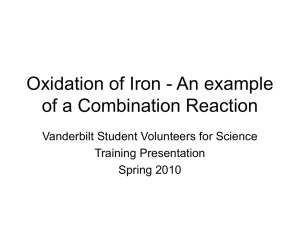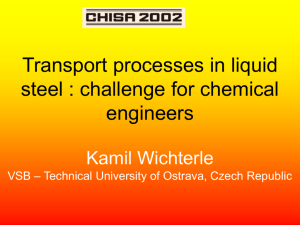Phase Behavior in Iron/Carbon System
advertisement
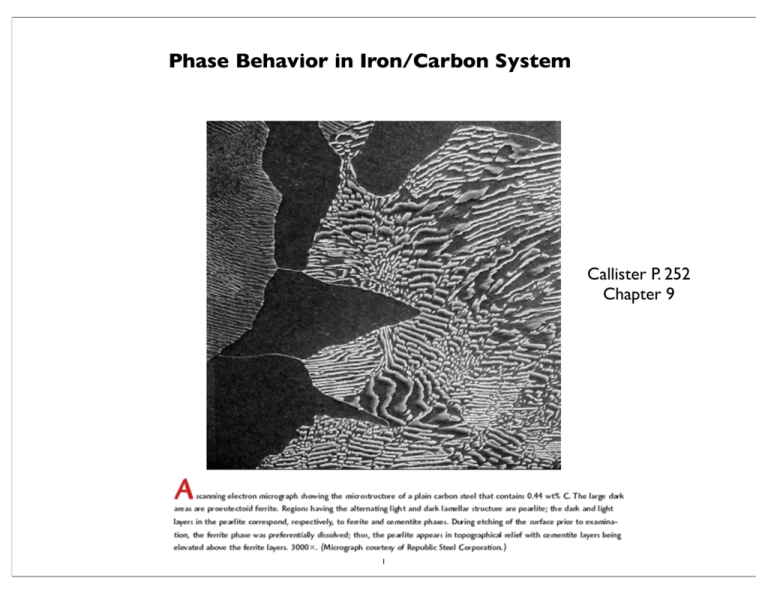
Phase Behavior in Iron/Carbon System Callister P. 252 Chapter 9 1 Iron Age 1500 to 1000 BC Iron Ore is extremely common and was used as a fluxing agent in copper smelting from malachite (Copper carbonate) Making an iron rich slag. Melting point is 1538°C 2 Iron Ore was used as a fluxing agent in copper smelting from malachite (Copper carbonate) Making an iron rich porous slag, sponge iron. Copper Slag contains some reduced iron as sponge iron. Hammering compacts the sponge producing wrought iron. Bronze is harder than pure iron Iron is also subject to corrosion So pure iron is not an advancement over Bronze 3 Hittites (Turkey) repeatedly heated bloom in charcoal furnaces at 1200°C Followed by working with a hammer CO lead to the diffusion of C into the iron at the surface Case Hardened Steel Even a fraction of a percent of carbon can have a dramatic effect on hardness Hittites needed to beat bronze in terms of hardness so their weapons could pierce bronze shields Quenching also hardened steel (Martensite) (followed by tempering (heating)) 4 Iron/Carbon Phase Diagram Iron shows a eutectic with Carbon allowing for a lower melting alloy FCC BCC Orthorhombic Martensite (non equilibrium BCT phase from quench of γ) Body Centered Tetragonal 5 6 7 Carbon content can be reduced by reaction with oxygen and stirring 8 9 Eutectoid Steel Pearlite 10 Time-Temperature-Transformation Diagram 11 Time-Temperature-Transformation Diagram Just below 727°C Thermodynamics drive is low so time is long 12 Time-Temperature-Transformation Diagram Well below 727°C Diffusion is slow so time is long 13 Time-Temperature-Transformation Diagram At very deep quenches Diffusionless Transformation Occurs: Martinsitic Transformation 14 Hypoeutectoid Steel 15 Hypoeutectoid Steel 16 Hypoeutectoid Steel 17 Hypoeutectoid Steel 18 19 Hypereutectoid Steel 20 21 Kinetics of Phase Growth 22 23 Heat Treatment of Steel Quench and tempering: This is the most common heat treatment encountered, because the final properties can be precisely determined by the temperature and time of the tempering. Tempering involves reheating quenched steel to a temperature below the eutectoid temperature then cooling. The elevated temperature allows very small amounts of spheroidite to form, which restores ductility, but reduces hardness. Actual temperatures and times are carefully chosen for each composition. Spheroidizing: Spheroidite forms when carbon steel is heated to approximately 700 °C for over 30 hours. Spheroidite can form at lower temperatures but the time needed drastically increases, as this is a diffusion-controlled process. The result is a structure of rods or spheres of cementite within primary structure (ferrite or pearlite, depending on which side of the eutectoid you are on). The purpose is to soften higher carbon steels and allow more formability. This is the softest and most ductile form of steel. Process annealing: A process used to relieve stress in a cold-worked carbon steel with less than 0.3 wt% C. The steel is usually heated up to 550–650 °C for 1 hour, but sometimes temperatures as high as 700 °C. 24 Martensite Austinite => Martensite Transformation FCC => BCT 25 26 27 28 29 30 31 32 33 34 35 36 37 38 39 40 41 42 43 44

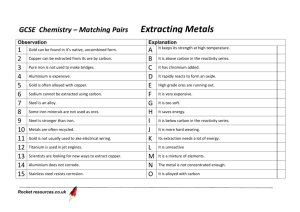


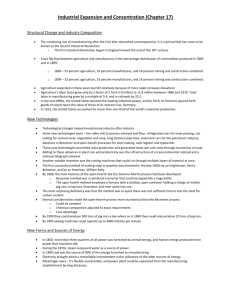

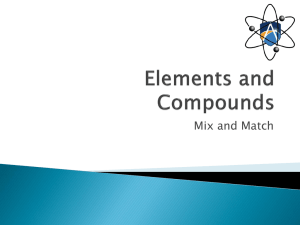
![Hlinsko [CR] > Praha přes Pardubice](http://s3.studylib.net/store/data/008946157_1-1c034385b612dae591a6c90cf1135c97-300x300.png)
